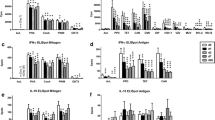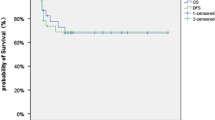Summary
The effects of cefodizime (CDZ) on lymphocyte differentiation were investigated in a randomized study before, on day 4 and on the day after five days of antineoplastic treatment with vepesid, bleomycin and cisplatin. Nine men with testicular cancer received CDZ 2 g i.v. once daily for seven days and 11 received no antibiotic treatment. A significant fall in the absolute numbers of platelets, erythrocytes, leucocytes and all T-cell subsets was observed in both groups. No change in the relative numbers of lymphocyte subpopulations was observed in the control group, whereas a significant rise in the percentage of CD4 positive (T helper/inducer) cells was observed in the CDZ group. Along with a decrease in CD8 positive (T suppressor/cytotoxic) cells, this led to an increase in the CD4/CD8 ratio. In both groups a decrease of mitogen-induced lymphocyte proliferation was observed in the lymphocyte transformation test, particularly leading to a long-lasting impairment of the proliferative capacity of PWM-dependent B lymphocytes. In two patients CDZ may have contributed to an increase in PHA-induced lymphocyte transformation during chemotherapy. It is concluded that CDZ induces an increase in both the percentage of CD4 positive (T helper/inducer) cells and the CD4/CD8 ratio in patients with testicular cancer undergoing antineoplastic therapy.
Zusammenfassung
In einer randomisierten Vergleichsstudie wurde der Einfluß von Cefodizim (CDZ) auf die Lymphozyten-Differenzierung untersucht. Kontrollen fanden vor Beginn eines fünftägigen Chemotherapiezyklus mit Vepesid, Bleomycin und Cisplatin, am 4. Tag desselben sowie am Tag danach statt. Neun Männer mit Hodenkarzinom wurden sieben Tage lang mit CDZ 1 × 2 g i.v. behandelt, 11 erhielten kein Antibiotikum. In beiden Gruppen kam es zu einem signifikanten Absinken der Thrombozyten-, Erythrozyten- und Leukozytenzahlen sowie aller Lymphozyten-Subpopulationen. In der Kontrollgruppe wurde keine Veränderung im Verhältnis der T-Zell Subpopulationen zueinander festgestellt, während es in der CDZ-Gruppe zu einem signifikanten Anstieg der CD4 positiven (T-Helfer/Induktor) Zellen kam. Zusammen mit einer parallelen Tendenz zum Absinken der CD8 positiven (T-Suppressor/zytotoxischen) Zellen führte dies zu einem Ansteigen des CD4/CD8 Quotienten. Im Lymphozyten-Transformationstest zeigte sich ein vorübergehender Rückgang des Proliferations-Potentials von T-Lymphozyten und eine längerdauernde Beeinträchtigung der PWM-abhängigen Stimulation der B-Lymphozyten. Bei zwei Patienten in der CDZ-Gruppe kam es während der Chemotherapie zu einem relevanten Anstieg der Proliferation nach PHA-Stimulation. Schlußfolgerung: CDZ führte bei Patienten mit Hodenkarzinom während eines antineoplastischen Chemotherapiezyklus zu einem prozentuellen Ansteigen der CD4 positiven (T-Helfer/Induktor) Zellen und der CD4/CD8-Ratio.
Similar content being viewed by others
References
Samuels, M. L., Lanzotti, V. J., Holoye, P. Y. Combination chemotherapy in germinal cell tumors. Cancer Treat. Rev. 3 (1976) 185–204.
Einhorn, L. H., Donohue, J. Cis-diaminedichloroplatinum, vinblastine and bleomycin combination chemotherapy in disseminated testicular cancer. Ann. Intern. Med. 87 (1977) 293–298.
Einhorn, L. H., Williams, S. D. Chemotherapy of disseminated testicular cancer — a random prospective study. Cancer 46 (1980) 1339–1344.
Steurer, G., Kuzmits, R., Pavelka, M. Vinblastine induced thrombocytopenia during polychemotherapy of disseminated testicular cancer. Blut 51 (1985) 172.
Aiginger, P., Kuzmits, R. Hodentumoren. In:Dittrich, Ch. (ed.): Angewandte Onkologie. Springer Verlag, Vienna 1989, pp. 24–55.
Simon, C., Stille, W. Antibiotikatherapie. Schattauer, Stuttgart 1989, pp. 661–667.
Limbert, M., Bartlett, R. R., Dickneite, G., Klesel, N., Schorlemmer, H. U., Seibert, G., Winkler, I., Schrinner, E. Cefodizime, an aminothiazolyl cephalosporin. IV. Influence on the immune system. J. Antibiot. 37 (1984) 1719–1726.
Miyake, Y., Tomonaga, M., Tokoh, T., Yamada, Y., Ishida, N., Hyodo, A. Therapeutic efficacy of cefodizime against experimental infections in immunosuppressed mice. Chemotherapy (Tokyo) 36 (1988) 128–139.
Carandente, F., De Vecchi, A., Halberg, F., Cornelissen, G., Dammacco, F. Toward a chronoimmunomodulation by cefodizime in multiple myeloma and chronic uremia. Chronobiologia 15 (1&2) (1988) 61–85.
Vanholder, R., Van Landschoot, N., Dagrosa, E., Ringoir, S. Cefodizime: a new cephalosporin with apparent immunestimulating properties in chronic renal failure. Nephrol. Dial. Transplant. 2 (1988) 221–224.
Author information
Authors and Affiliations
Rights and permissions
About this article
Cite this article
Mallmann, P., Brühl, P. Immunological effects of cefodizime in patients undergoing antineoplastic chemotherapy. Infection 20 (Suppl 1), S67–S70 (1992). https://doi.org/10.1007/BF01709958
Issue Date:
DOI: https://doi.org/10.1007/BF01709958




